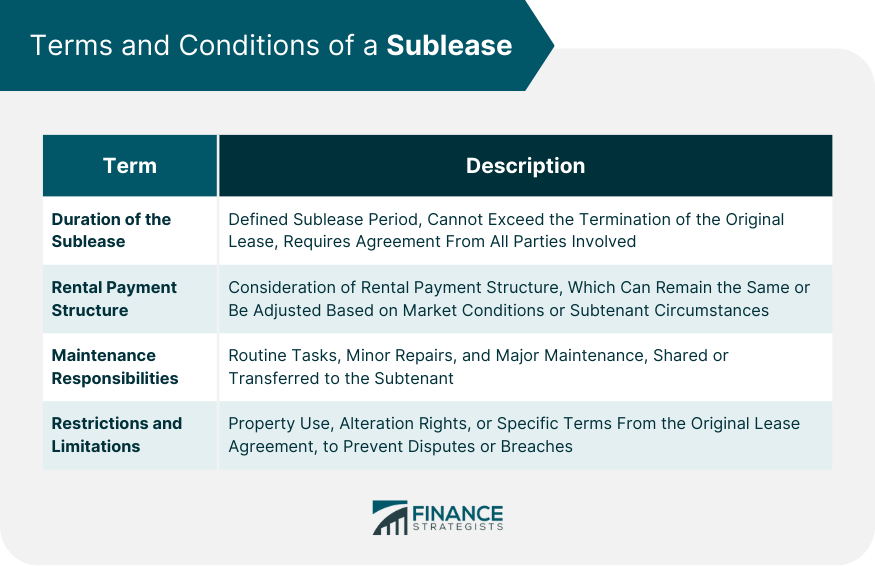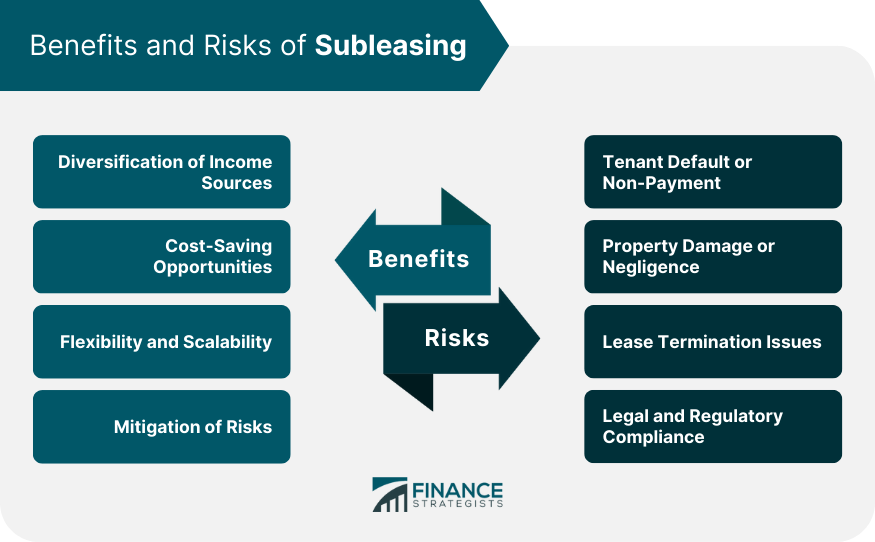A sublease refers to an arrangement where a tenant leases all or a portion of their rented property to another party, known as the subtenant. In this agreement, the original tenant becomes the sublessor and assumes the role of the landlord to the subtenant. The sublease typically occurs when the primary tenant wishes to temporarily vacate the property but doesn't want to terminate their lease. It allows them to sublet the space to another individual, who becomes responsible for paying rent and adhering to the terms of the sublease agreement. While the sublessor retains legal responsibility for the lease with the landlord, they essentially become a landlord themselves to the subtenant. Subleasing provides flexibility for tenants and allows them to mitigate financial obligations during periods of absence or when they have excess space. All parties involved must carefully review and agree upon the terms of the sublease to ensure clarity and protect their respective rights and responsibilities. The duration of the sublease is a critical term in any subletting agreement. It should be clearly defined and cannot extend beyond the termination of the original lease. This term needs to be agreed upon by all parties involved, including the landlord, tenant, and subtenant. Another important consideration is the rental payment structure. This may remain the same as in the original lease, or it could be revised based on current market conditions or specific circumstances of the subtenant. The tenant may choose to charge a higher rent if the property is in high demand or if they are providing additional services or amenities. Maintenance responsibilities in a sublease need to be clearly outlined. This includes routine tasks such as cleaning and minor repairs, as well as major maintenance issues. The original tenant typically retains certain responsibilities, but these can be shared or transferred to the subtenant. Sublease agreements often come with certain restrictions and limitations. These may pertain to the use of the property, alteration rights, or other specific terms set forth in the original lease agreement. Understanding these restrictions is vital to avoid potential disputes or breaches of the agreement. Subleasing allows property owners to diversify their income sources. By leasing out a portion of their property or unused spaces, they can generate additional income and increase their return on investment. This diversification can also serve as a hedge against economic fluctuations and property market volatilities. Subleasing can also present significant cost-saving opportunities. It enables property owners to offset their rental costs by sharing them with a subtenant. This can be especially beneficial if the tenant has unutilized space or is temporarily unable to use the property. Subleasing offers a level of flexibility and scalability that can be beneficial in wealth management. It allows tenants to adapt their property commitments based on their current needs or financial situation. This flexibility can be particularly valuable in dynamic property markets or uncertain economic environments. In certain scenarios, subleasing can help mitigate financial risks. For instance, if a tenant experiences unexpected financial difficulties or has to vacate the property temporarily, they can mitigate potential losses through a sublease. The original tenant remains responsible for the payment of rent to the landlord, regardless of whether the subtenant fulfills their rental obligations. This risk can be managed through a thorough screening process and clear contractual terms. Another risk is potential property damage or negligence by the subtenant. While the original tenant can seek compensation from the subtenant, they are still primarily responsible for maintaining the condition of the property and adhering to the terms of the original lease. Lease termination issues can pose challenges in subleasing arrangements. If the original lease is terminated prematurely or if the landlord does not permit subleasing, it can disrupt the sublease agreement. It is crucial for the tenant to review the terms of their lease and obtain consent from the landlord before entering into a sublease. Complying with legal and regulatory requirements is essential when engaging in subleasing. Laws and regulations regarding subleases can vary by jurisdiction, and failure to comply can result in legal consequences. It is important to consult with legal professionals or real estate experts to ensure adherence to all relevant laws and regulations. Subleasing involves complex legal and contractual considerations. It is crucial to draft a well-defined sublease agreement that outlines the rights, responsibilities, and obligations of all parties involved. Seeking legal guidance to ensure compliance with local laws and regulations is essential to protect the interests of the original tenant. Thoroughly screening potential subtenants by reviewing their financial stability, rental history, and references can help mitigate the risk of non-payment or property damage. Background checks and verifying their business credentials can provide additional assurance. Strategic portfolio diversification can be achieved through subleasing. Property owners can carefully select subtenants based on their industry, stability, and potential for long-term occupancy. This diversification can reduce dependency on a single tenant or property type, thereby spreading risks and optimizing income streams. Active management and monitoring of subleases are necessary to ensure compliance with the terms and conditions of the sublease agreement. Regular communication with subtenants, periodic property inspections, and timely resolution of any issues are crucial for a successful subleasing arrangement. A sublease refers to an arrangement where a tenant leases out their rented property to a subtenant for a specific period within the term of the original lease. It involves considerations such as the duration of the sublease, rental payment structure, maintenance responsibilities, and restrictions or limitations. Subleasing offers several benefits in wealth management. It allows for the diversification of income sources, providing an additional stream of revenue. It also presents cost-saving opportunities, as the tenant can offset rental costs by sharing them with the subtenant. Moreover, subleasing offers flexibility and scalability, enabling tenants to adapt their property commitments based on their current needs or financial situation. It also serves as a risk mitigation strategy, reducing the potential impact of vacancy and income loss.What Is a Sublease?
Terms and Conditions of a Sublease
Duration of the Sublease
Rental Payment Structure
Maintenance Responsibilities
Restrictions and Limitations

Benefits of Subleasing
Diversification of Income Sources
Cost-Saving Opportunities
Flexibility and Scalability
Mitigation of Risks
Risks in Subleasing
Tenant Default or Non-payment
Property Damage or Negligence
Lease Termination Issues
Legal and Regulatory Compliance

Considerations in Subleasing
Legal and Contractual Aspects
Due Diligence on Subtenants
Portfolio Diversification Strategies
Monitoring and Managing Subleases
The Bottom Line
Sublease FAQs
A sublease refers to an arrangement where a tenant leases out their rented property to a subtenant for a specific period within the term of the original lease.
Subleasing offers benefits such as diversification of income sources, cost-saving opportunities, flexibility, and risk mitigation.
Risks in subleasing include tenant default or non-payment, property damage or negligence, lease termination issues, and legal and regulatory compliance.
Legal considerations in subleasing include drafting a comprehensive sublease agreement, obtaining landlord consent, and ensuring compliance with local laws and regulations.
Subleases can be effectively managed through active monitoring, due diligence on subtenants, strategic portfolio diversification, and regular communication with subtenants to address any issues promptly.
True Tamplin is a published author, public speaker, CEO of UpDigital, and founder of Finance Strategists.
True is a Certified Educator in Personal Finance (CEPF®), author of The Handy Financial Ratios Guide, a member of the Society for Advancing Business Editing and Writing, contributes to his financial education site, Finance Strategists, and has spoken to various financial communities such as the CFA Institute, as well as university students like his Alma mater, Biola University, where he received a bachelor of science in business and data analytics.
To learn more about True, visit his personal website or view his author profiles on Amazon, Nasdaq and Forbes.











